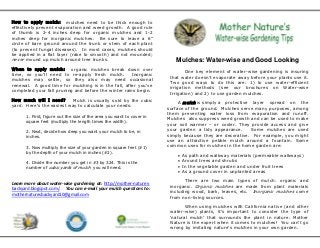
Garden Mulches - brochure
- 1. How to apply mulch: mulches need to be thick enough to effectively prevent evaporation and weed growth. A good rule of thumb is 2-4 inches deep for organic mulches and 1-2 inches deep for inorganic mulches. Be sure to leave a 6” circle of bare ground around the trunk or stem of each plant (to prevent fungal diseases). In most cases, mulches should be applied in a flat layer (rake to smooth) and not mounded; never mound up mulch around tree trunks. Mulches: Water-wise and Good Looking When to apply mulch: organic mulches break down over One key element of water-wise gardening is insuring time, so you’ll need to re-apply fresh mulch. Inorganic that water doesn’t evaporate away before your plants use it. mulches may settle, so they also may need occasional Two good ways to do this are: 1) to use water-efficient renewal. A good time for mulching is in the fall, after you’ve irrigation methods (see our brochures on Water-wise completed your fall pruning and before the winter rains begin. Irrigation) and 2) to use garden mulches. How much will I need? Mulch is usually sold by the cubic A mulch is simply a protective layer spread on the yard. Here’s the easiest way to calculate your needs: surface of the ground. Mulches serve many purposes, among them preventing water loss from evaporation and runoff. 1. First, figure out the size of the area you want to cover in square feet (multiply the length times the width). Mulches also suppress weed growth and can be used to make your soil warmer – or cooler. They provide access and give 2. Next, decide how deep you want your mulch to be, in your garden a tidy appearance. Some mulches are used inches. simply because they are decorative. For example, you might use an attractive pebble mulch around a fountain. Some 3. Now multiply the size of your garden in square feet (#1) common uses for mulches in the home garden are: by the depth of your mulch in inches (#2). As path and walkway materials (permeable walkways) 4. Divide the number you get in #3 by 324. This is the Around trees and shrubs number of cubic yards of mulch you will need. In the vegetable garden and under fruit trees As a ground cover in unplanted areas Learn more about water-wise gardening at: http://mother-natures- There are two main types of mulch: organic and inorganic. Organic mulches are made from plant materials backyard.blogspot.com/. You can e-mail your mulch questions to: including wood, bark, leaves, etc. Inorganic mulches come mothernaturesbackyard10@gmail.com from non-living sources. When using mulches with California native (and other water-wise) plants, it’s important to consider the type of ‘natural mulch’ that surrounds the plant in nature. Mother Nature is the expert when it comes to mulches! You can’t go wrong by imitating nature’s mulches in your own garden.
- 2. The basic types of mulches and their best uses in the garden are outlined below: None No mulch/ bare ground Annual wildflowers; local native grasses; native Salvias, Penstemons & Buckwheats Chipped bark Many native trees & shrubs; pine & fir trees; many other trees, shrubs Shredded Bark (‘gorilla hair’ Many native and non-native trees & shrubs; best choice for slopes, hillsides mulch) Many native and water-wise plants; be sure to get fresh from a tree trimmer (free Wood chips mulch from city/park mulch piles may contain weed seeds) Nut hulls ‘Woodland’ type plantings; around strawberries, fruit trees; as decorative mulch Organic Pine needles Under forest-type trees/plants (pines, etc); on slopes; around ‘acid loving’ plants Straw/Grass clippings Vegetable garden; cheap, but may have weed seeds Composted ‘green waste’ Vegetable garden & conventional (non-native) flower beds Commercial ‘topper’ or ‘top Conventional (non-native) flower beds; roses dressing’ products Gravel; fine-grade crushed Annual wildflowers; bulbs; desert plants; native Salvias, Penstemons, Buckwheats; rock (small size particles); pots & planters; walkways & seating areas decomposed granite Crushed rock (larger size) Decorative uses; in rain gardens & infiltration swales; pots/planters; bulbs Pebbles (rounded rocks) Decorative uses; around ponds; in rain gardens & infiltration swales; pots/planters Inorganic Shredded/Ground rubber Play areas; around fruit trees Glass & other decorative Decorative uses; around ponds; in rain gardens & infiltration swales; pots/planters Plastic sheeting/ weed-block Under pathways, seating areas; temporary mulch (when clearing weeds/grass) Newspaper/cardboard As temporary mulch when clearing an area of weeds/grass or under pathways